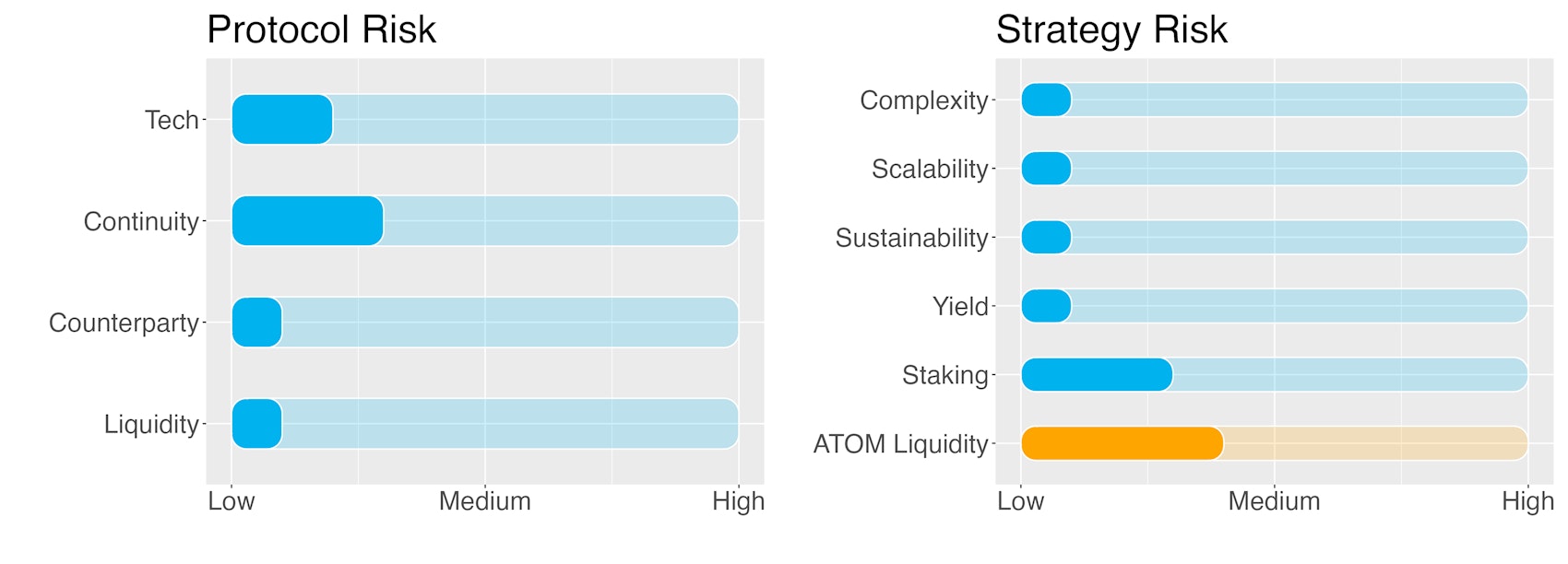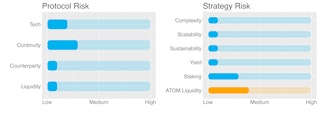

Staking via Kiln


Key Takeaways
- Staking represents one of the safest options in DeFi to generate yield.
- Kiln is considered a secure and trustable staking service.
- The yield (APY) is derived from staking ATOM tokens – contributing to the Proof-of-Stake consensus mechanism of the Cosmos blockchain.
- The Cosmos network was founded in 2014 by developers Jae Kwon and Ethan Buchman. The first brick in the creation of the project was the development of Tendermint, the consensus algorithm that would go on to power Cosmos. By 2016 Cosmos had turned into a reality and on 13 March 2019 the Cosmos Hub was launched.
- ATOM liquid staking represents a liquidity yield-generating investment. No lockup period is present for this strategy but a 22-day cooldown is required to fully unstake the asset.
- Risk Checklist. In our view the predominant risks for this strategy are as follows: - Tech risk - Project continuity risk - Liquidity risk of staking
1. Strategy Explained
The strategy involves liquid staking ATOM tokens in Kiln.
Lockup period: None.
Cooldown: 22 days
2. Risks
Trust Score
Kiln is the leading enterprise-grade staking platform, enabling institutional customers to stake assets, and to whitelabel staking functionality into their offering. The platform is API-first and enables fully automated validators, rewards, data and commission management.
SwissBorg has performed its own due diligence on the protocol and considers it trustable.
Protocol Risks
Project Continuity Risk
Project continuity risk is low.
Kiln is a Paris-based start-up that provides a service known as “staking” for blockchains.
By locking up their tokens (i.e. stake them), users join others in validating transactions on the blockchain, which protects the network from potential attack.
In November 2022 the company raised 17 million euros in a Series A funding round from a group of investors that included crypto incubator Consensys, investment firm GSR and crypto exchange Kraken's venture-capital arm. These funds have been used to expand the ‘staking-as-a-service’ offerings.
‘Staking-as-a-service’ products make it easy for custodians, exchanges, wallets and treasury managers to commit their digital assets to the blockchain. At the time of writing Kil is the 9th largest ETH staker (over 500k staked ETH).
The project is relatively new and not battle tested but given the growth of the staking practice the continuity risk should be contained.
Kiln continuity risk is set to 3/10.
Counterparty Risk
Counterparty risk is deemed low.
Counterparty risk exists whenever an asset is handed over to an external provider. Any credit events involving the staking provider could affect the assets that have been entrusted to them.
That said, staking via a 3rd party is fundamentally different from depositing funds into a lending protocol that later becomes insolvent.
In a Proof-of-Stake protocol, tokens are locked up in a validator to secure the underlying network and receive staking rewards in return.
Those validators, with the assets and rewards they hold, are fully transparent and always verifiable "on-chain". This is contrary to centralized company reserves which can be opaque and under-collateralized, as it has been seen in the case of some famous crypto exchange, now bankrupt.
With staking, there is no counterparty but the network itself. Validators are rewarded by operations automatically through preset ‘block reward’ rules, as well as through a share of transaction fees. There is no risk of default or bank runs.
Counterparty risk is 1/10.
Liquidity Risk
Liquidity risk is deemed low.
Funds held by the staking provider are redeemable after the required (if any) lockup and cooldown periods. In no circumstances would one expect instances of illiquidity during the redemption process.
Liquidity risk is 1/10.
Strategy Risks
Complexity
Complexity of the strategy is low.
The strategy involves depositing ATOM on Kiln to perform staking. One chain (ATOM), 1 token and one staking service is employed with no leverage.
The complexity risk of the strategy is 1/10.
Scalability
The scalability risk is low.
Staking is a highly scalable practice. Indeed, the more stakers are participating, the higher the safety of the blockchain.
The scalability risk of the strategy is 1/10.
Sustainability
The sustainability risk is low.
The yield obtained from this strategy is fully sustainable as it comes from participating in the validation of ATOM transactions, the Proof-of-Stake mechanism.
Proof-of-Stake is quite energy efficient when compared to Proof-of-Work chains like Bitcoin and has therefore practically no negative impact on the environment.
The sustainability risk of the strategy is 1/10.
Yield Risk
Yield risk of strategy is low.
Staking provides a constant stream of income with low variability.
The yield risk of the strategy is 1/10.
Slashing Risk
The slashing risk of the strategy is low.
The Proof of Stake consensus mechanism requires participants to behave responsibly for the overall good of the ecosystem. For this reason, blockchains penalise validators if they step out of line by slashing the value of their stake. The two most common offenses are double-signing or going offline when the validator should be available to confirm a new block.
Cosmos’ staking model uses ‘hard slashing’, which sounds a bit violent, but only means that customer funds are at risk of being slashed in the event of ‘double-signing blocks or extended validator downtime’.
Double spending on the Cosmos protocol comes with a 5% slashing penalty and a 0.01% slashing for downtime.
Kiln’s technology helps mitigate these outcomes by providing the required maintenance.
The slashing risk of the strategy is 3/10.
Liquidity Risk of Staking
Liquidity Risk on staking ATOM is low.
Staking ATOM on Kiln requires no lockup but a cooldown period of 22 days. Regardless of the direction the market chooses during this time, your assets will be out of reach.
The liquidity risk is therefore set to 4/10.
3. Conclusions
ATOM staking comes with little risk.
Staking per se is generally considered a very safe investment.
Kiln, the chosen liquid staking service provider, has been reviewed and approved by the SwissBorg tech team.
ATOM staking comes with no lockup but a 22-day cool down period. Liquidity is therefore readily available.
The SwissBorg Risk Team ranks ATOM staking as a Low risk investment, one for an investor with some understanding of DeFi and yielding, who is willing to take on a minimum amount of risk – while remembering that there is no free lunch! – in exchange for an acceptable reward on ATOM.




